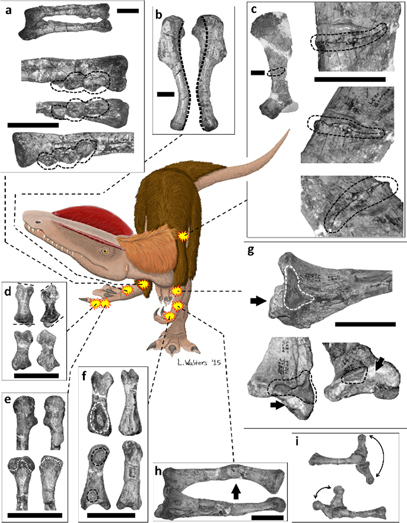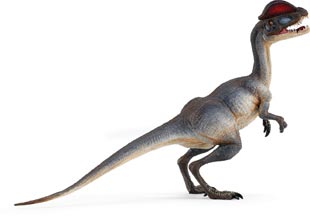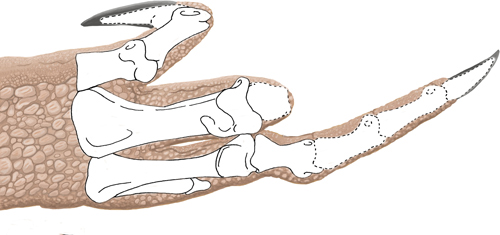A Damaged Dilophosaurus! Remarkable Fossil Provides a Fresh Perspective on Dinosaurs
Scientists Examine the Pathology Preserved on the Dilophosaurus wetherilli Holotype
Life was tough for the Dinosauria, the Mesozoic was no “walk in the Jurassic Park”, that’s for sure. However, detailed analysis of injuries or disease preserved in the fossilised bones of dinosaurs does not take place that often. Here we report on a paper published in the on line, academic journal PLOS One that provides a comprehensive account of the pathology on the holotype specimen of the theropod dinosaur Dilophosaurus (D. wetherilli).
The Pathology of a Dilophosaurus Specimen (UCMP 37302)
Picture credit: PLOS One (L. Walters)
Dilophosaurus – Lithe Early Jurassic Carnivore
At around six metres in length, Dilophosaurus was one of the largest carnivorous dinosaurs known from the Early Jurassic. A number of species have been described, fossils of D. wetherilli are associated with the Kayenta Formation of Arizona. Both jaws were relatively light and slender and the upper jaw had a distinctive kink. Studies of the dentition (teeth) and analysis of skull stresses indicates that this dinosaur probably specialised in hunting relatively small prey. It may also have scavenged the kills of other dinosaurs.
Dilophosaurus a Light and Agile Theropod
Picture credit: Everything Dinosaur
Safari Ltd have introduced two Dilophosaurus models into their model range: Safari Ltd. Wild Safari Prehistoric World Models.
A Damaged Dilophosaurus
The holotype specimen shows eight substantial injuries, signs of healing indicate that this unfortunate meat-eater survived the traumas, but it probably spent a considerable portion of its adult life in quite a lot of pain. On the left side of the dinosaur, the shoulder blade (scapula) is fractured (c in the pathology illustration above), the left radius shows a severe fracture that has healed (h). The ulna shows signs of infection and the left thumb (digit I) had been dislocated, highlighted as (f) in the diagram at the top of the article. On the right side of the holotype, more pathology can be found.
Abnormal torsion of the right humerus (b), three bony tumours on the radius (a), along with damage to metacarpal III (e). The right finger was so badly damaged (i), that it could not flex properly. Some of the deformities, the researchers conclude, are the result of osteodysplasia, a condition that causes bone growth defects. This is known in modern birds but has not been reported before in non-avian dinosaurs.
The Badly Damaged Right Hand of the Holotype Specimen (UCMP 37302)
Picture credit: PLOS One (L. Walters)
Damaged Digits
The damage to the digits would have meant that this dinosaur would have been severely hampered as it tried to grasp prey. How the injuries were caused remains the subject of speculation. The authors of the paper, Phil Senter (Department of Biological Sciences, Fayetteville State University, North Carolina) and Sara Juengst (Department of Anthropology, Appalachian State University, North Carolina) state that it is not possible to determine the number of traumatic events that all these pathological features preserved in the skeleton represent.
All the injuries and damage could have been sustained in one catastrophic event, perhaps in a fight with a rival or in an attempt to subdue prey. The authors can at least be certain that this Dilophosaurus survived for some considerable time as the injuries show signs of extensive healing, although it would have been in a great deal of discomfort. The fact that this dinosaur survived is a testament to how hardy these reptiles were. It is also intriguing to speculate how this dinosaur fed whilst recovering from its various debilitating injuries. It may have subsisted on very small prey, small enough to be subdued by the mouth and or feet.
Pathology in Dinosaurs
Injuries, trauma and general pathology in the Dinosauria is underreported. When describing a new dinosaur species, researchers often fail to mention any pathological features that have been found. For example, in the scientific description of the holotype specimen of Dilophosaurus wetherilli only one of the pathological features reported by the authors of this paper was described. This Dilophosaurus specimen is a record breaker for broken bones reported in the Dinosauria portion of the fossil record, even beating the famous Allosaurus (A. fragilis) called “Big Al”.




